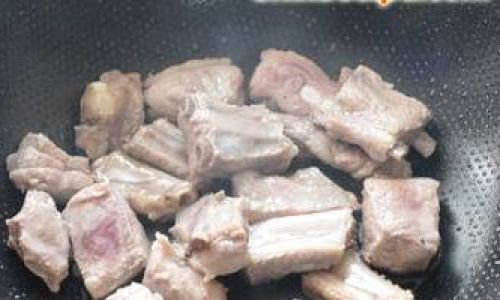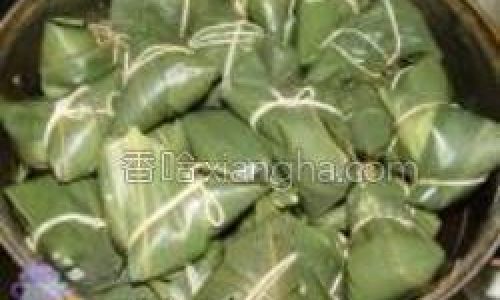Table of content
Zongzi, a beloved traditional Chinese dish, holds a cherished place in culinary heritage, particularly during the Dragon Boat Festival. These pyramid-shaped rice dumplings, wrapped in bamboo leaves, are filled with a harmonious blend of ingredients that vary by region and family recipe. Among the most cherished variations is the large lentil and spare rib zongzi, a savory-rich delight that combines tender meat, hearty legumes, and fragrant glutinous rice. This article will guide you through the intricate process of preparing this dish, from selecting ingredients to mastering the art of wrapping, ensuring your zongzi are both authentic and delicious.

The Cultural Significance of Zongzi
Before diving into the recipe, it is essential to appreciate the cultural tapestry woven into each zongzi. Legend has it that these dumplings were originally made to honor Qu Yuan, a patriotic poet and minister of ancient China, who drowned himself in the Miluo River to protest corruption. To prevent fish from devouring his body, locals threw sticky rice dumplings into the river—a tradition that endures today. Over centuries, zongzi has evolved into a symbol of unity, heritage, and seasonal celebration, with fillings reflecting local agriculture and taste preferences.
The combination of large lentils and spare ribs in this recipe pays homage to northern Chinese culinary traditions, where hearty, protein-rich fillings are favored. The lentils add a earthy sweetness and creamy texture, while the spare ribs contribute a rich, meaty depth, balanced by the aromatic embrace of bamboo leaves.
Ingredients: Assembling the Essentials
Creating exceptional zongzi begins with sourcing high-quality ingredients. Here’s a detailed breakdown of what you’ll need:
For the Glutinous Rice Base
- 500g glutinous rice: Also known as sticky rice, this variety is essential for the dumplings’ signature chewiness. Rinse thoroughly and soak overnight in cold water to soften.
- 1 tbsp dark soy sauce: For depth of color and umami flavor.
- 1 tbsp light soy sauce: To balance saltiness without overpowering.
- 1 tbsp sesame oil: Adds a nutty aroma.
- 1 tsp five-spice powder: A blend of star anise, cloves, cinnamon, Sichuan pepper, and fennel seeds, available in Asian grocery stores.
For the Filling
- 300g pork spare ribs: Opt for meaty ribs cut into 2-inch pieces. Marinate for at least 2 hours (ideally overnight) to infuse flavor.
- Marinade for spare ribs:
- 2 tbsp soy sauce
- 1 tbsp oyster sauce
- 1 tbsp Shaoxing wine (or dry sherry)
- 1 tbsp minced garlic
- 1 tbsp grated ginger
- 1 tsp sugar
- 1 tsp white pepper
- 150g dried large lentils (mash beans): Soak for 4 hours or until plump. These lentils retain their shape during cooking, offering a pleasing contrast to the soft rice.
- 50g dried shrimp (optional): Rehydrate in warm water for 20 minutes; adds a briny umami kick.
- 3–4 dried mushrooms (shiitake preferred): Soak until soft, then slice into strips.
For the Wrapping
- 20–25 bamboo leaves: Fresh or dried. If dried, soak in hot water for 1 hour until pliable.
- Kitchen twine or raffia: To secure the dumplings.
For Cooking
- 1 tbsp salt: Added to the cooking water to season the rice.
- Water: Enough to submerge the zongzi during boiling.
Step-by-Step Preparation
Preparing the Glutinous Rice
Drain the soaked glutinous rice and transfer it to a large mixing bowl. Combine with dark soy sauce, light soy sauce, sesame oil, and five-spice powder. Toss gently until the rice is evenly coated. Let it marinate for 1–2 hours to absorb the flavors.
Marinating the Spare Ribs
In a bowl, combine the spare rib pieces with soy sauce, oyster sauce, Shaoxing wine, garlic, ginger, sugar, and white pepper. Ensure each rib is coated, then cover and refrigerate. The longer the marination, the deeper the flavor.
Preparing the Lentils and Aromatics
Drain the soaked lentils and mix with the rehydrated dried shrimp (if using) and sliced mushrooms. Set aside. These ingredients will add layers of texture and savory complexity.
Assembling the Zongzi
This is the most delicate phase, requiring patience and practice. Follow these steps:

-
Leaf Preparation:
- If using fresh bamboo leaves, wipe them clean. For dried leaves, soak in hot water until pliable, then rinse.
- Trim any tough stems with scissors.
-
Wrapping Technique:
- Layer Two Leaves: Overlap two bamboo leaves vertically, shiny sides down, to form a cross. The overlap should be about one-third of the leaf length.
- Fold into a Cone: Fold the leaves upward from the center to create a cone shape, leaving a 3-inch opening at the top. Ensure the cone is tight to prevent leakage.
- Layer Ingredients:
- Add a spoonful of seasoned rice to the cone’s base.
- Place 1–2 spare rib pieces, followed by a spoonful of lentils and mushrooms.
- Top with another layer of rice, leaving ½ inch of space at the top.
- Fold and Secure:
- Fold the overlapping leaves over the filling, pressing gently to shape a pyramid.
- Fold the tail ends of the leaves downward, tucking them neatly.
- Tie the zongzi tightly with kitchen twine, looping around the middle and securing with a knot. Avoid overtightening, which may split the leaves.
Cooking the Zongzi
- Boiling Method:
- Fill a large pot with water, add salt, and bring to a rolling boil.
- Gently place the zongzi into the pot, ensuring they are fully submerged.
- Boil on medium heat for 2.5–3 hours. Check periodically and add hot water if needed to maintain coverage.
- Testing Doneness:
Carefully unwrap one zongzi after 2.5 hours. The rice should be glossy, tender, and cling together. The meat should be fall-off-the-bone tender.
Serving and Storage
- Serving:
- Let the zongzi cool slightly, then unwrap and serve warm.
- Traditional accompaniments include soy sauce, chili oil, or minced garlic.
- Storage:
- Refrigerate cooked zongzi for up to 5 days. Reheat by steaming or boiling for 15 minutes.
- Freeze for up to 3 months; thaw overnight before reheating.
Tips for Perfect Zongzi
- Leaf Pliability: Dried bamboo leaves require thorough soaking. Test by bending a leaf; it should flex without cracking.
- Filling Balance: Avoid overstuffing, as this can cause the leaves to tear. Aim for a 70% rice-to-filling ratio.
- Tying Technique: Use a double knot to prevent unraveling during cooking. If a zongzi leaks, wrap it in an additional leaf mid-cook.
- Altitude Adjustment: At high elevations, increase boiling time by 15–30 minutes to compensate for lower boiling points.
Variations and Creative Twists
While the classic recipe is timeless, feel free to experiment:
- Vegetarian Option: Replace spare ribs with marinated tofu or king oyster mushrooms.
- Spicy Kick: Add 1–2 chopped chili peppers to the rice marinade.
- Sweet Version: Substitute lentils with red bean paste and omit the soy sauce for a dessert zongzi.
Troubleshooting Common Issues
- Soggy Leaves: Ensure leaves are fully dried after rinsing. Pat gently with a towel before wrapping.
- Undercooked Rice: Prolong boiling time in 15-minute increments. Check multiple dumplings for consistency.
- Loose Wrapping: Use three leaves per zongzi for extra durability, or practice folding techniques with scrap leaves.
The Joy of Zongzi-Making
Crafting zongzi is as much a cultural ritual as a culinary endeavor. Gathering family or friends to assemble dumplings together fosters connection and laughter, with each imperfectly wrapped zongzi becoming a badge of honor. Whether enjoyed fresh from the pot or packed as a picnic treat, these large lentil and spare rib zongzi embody the essence of tradition—a flavorful bridge between past and present.
Conclusion
Mastering the art of zongzi-making is a rewarding journey that celebrates patience, precision, and the joy of shared meals. This recipe, with its harmonious blend of textures and flavors, offers a gateway to exploring China’s rich culinary tapestry. As you wrap your first zongzi, remember that each fold carries a story—a testament to generations of cooks who have perfected this timeless craft. Soak the rice, marinate the meat, and let the aroma of bamboo leaves fill your kitchen. Your effort will be rewarded with dumplings that delight the senses and nourish the soul.





0 comments